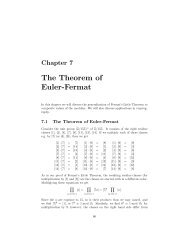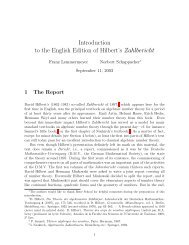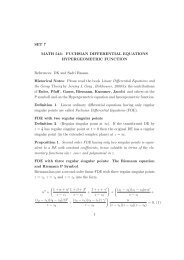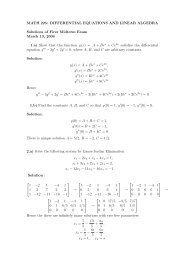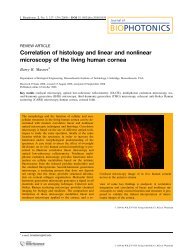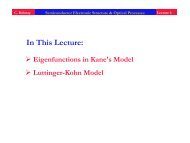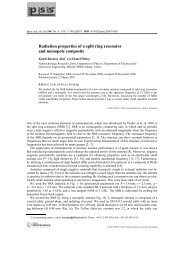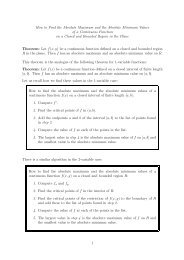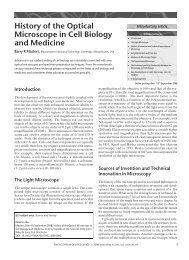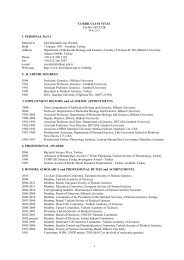Jump processes in surface diffusion - Bilkent University - Faculty of ...
Jump processes in surface diffusion - Bilkent University - Faculty of ...
Jump processes in surface diffusion - Bilkent University - Faculty of ...
Create successful ePaper yourself
Turn your PDF publications into a flip-book with our unique Google optimized e-Paper software.
48 G. Antczak, G. Ehrlich / Surface Science Reports 62 (2007) 39–61<br />
Fig. 24. Replacement <strong>of</strong> Pt adatom on Ni(100) by Ni atom [49]. (a) Pt atom<br />
deposited on Ni(100) at 77 K. (b) After heat<strong>in</strong>g to 250 K for one m<strong>in</strong>ute, Pt<br />
adatom disappears. (c) After partial field evaporation. (d) On complete field<br />
evaporation <strong>of</strong> one layer <strong>of</strong> nickel, Pt atom reappears.<br />
as a possible mechanism [17,23,25,52–59], and roughly half<br />
favored atom exchange dur<strong>in</strong>g <strong>diffusion</strong>. For Ni(100) [17,59–<br />
71], out <strong>of</strong> a total <strong>of</strong> n<strong>in</strong>eteen estimates, only eight considered<br />
exchange as an option, and fewer than half <strong>of</strong> these <strong>in</strong>dicated<br />
an exchange <strong>of</strong> atoms as primary <strong>in</strong> the <strong>diffusion</strong> process.<br />
Here it is important to note the observation <strong>of</strong> Perk<strong>in</strong>s and<br />
DePristo [65] as well as <strong>of</strong> Chang and Wei [60] that the<br />
activation energy for exchange depends strongly on the size <strong>of</strong><br />
the cell used <strong>in</strong> the calculations, while the hopp<strong>in</strong>g energy is<br />
not sensitive to this factor. Much more work has been done to<br />
understand <strong>diffusion</strong> on Cu(100) [17,29,53,58–68,70–90,110–<br />
112]. Half the <strong>in</strong>vestigations considered exchange as an option,<br />
but only three studies gave an <strong>in</strong>dication <strong>of</strong> atom exchange<br />
tak<strong>in</strong>g place. For Pd(100) [17,27,59–62,64,66,69–71,92,93],<br />
three estimates favored hopp<strong>in</strong>g as the pr<strong>in</strong>cipal mechanism,<br />
but after <strong>in</strong>creas<strong>in</strong>g the size <strong>of</strong> the cell <strong>in</strong> the calculations<br />
three favoured exchange [17,60,65]. Only one out <strong>of</strong> six studies<br />
considered exchange <strong>in</strong> <strong>diffusion</strong> on Ag(100) [17,27,59–62,64–<br />
71,76,91,94–97,109–112] possibly <strong>in</strong>dicat<strong>in</strong>g a rate <strong>of</strong> atom<br />
exchange comparable to atom hopp<strong>in</strong>g; the rema<strong>in</strong>der gave<br />
hopp<strong>in</strong>g as the mode <strong>of</strong> <strong>diffusion</strong>. Not too much calculational<br />
work has been done to evaluate <strong>diffusion</strong> characteristics on<br />
Ir(100) [37,92], Pt(100) [17,92,98], and Au(100) [17,66,99],<br />
but all <strong>of</strong> them <strong>in</strong>dicate that the preferred path for <strong>diffusion</strong> was<br />
by atom exchange.<br />
Although the outcome <strong>of</strong> some <strong>of</strong> the theoretical estimates<br />
is not that certa<strong>in</strong>, the evidence is firm that exchange between<br />
an adatom and a lattice atom occurs <strong>in</strong> <strong>diffusion</strong> on (100)<br />
planes <strong>of</strong> Ir [45], Pt [44], and Ni [49], and probably also on<br />
Au [17,66,99]. There have been attempts to rationalize the<br />
conditions under which exchange will dom<strong>in</strong>ate <strong>in</strong> <strong>diffusion</strong>.<br />
For Al(100), Feibelman [100] po<strong>in</strong>ted out that the transition<br />
state for atom exchange was stabilized by the covalent nature<br />
<strong>of</strong> alum<strong>in</strong>um. Kellogg et al. [47] correlated exchange <strong>diffusion</strong><br />
with the relaxation <strong>of</strong> <strong>surface</strong> atoms around the b<strong>in</strong>d<strong>in</strong>g site <strong>of</strong><br />
the adatom. Yu and Scheffler [94] argued that “tensile <strong>surface</strong><br />
stress plays the key role for the exchange <strong>diffusion</strong> on fcc(100)<br />
<strong>surface</strong>s”, and is important not only for Au(100), but also for<br />
Fig. 25. Multiple atom exchange process <strong>in</strong> molecular dynamics simulation <strong>of</strong><br />
adatom on Cu(100) at 900 K [75]. Adatom (black) moves <strong>in</strong>to substrate, caus<strong>in</strong>g<br />
eventual emergence <strong>of</strong> a substrate atom at some distance from the orig<strong>in</strong>al entry.<br />
Al(100) and 5d metals. However, Feibelman and Stumpf [92]<br />
have done detailed density functional calculations for the (100)<br />
<strong>surface</strong>s <strong>of</strong> Rh, Ir, Pd, and Pt, and found no clear relation<br />
between <strong>surface</strong> stress and the <strong>diffusion</strong> barrier. Instead, they<br />
concluded that exchange <strong>diffusion</strong> was favored, as proposed<br />
by Kellogg et al. [47], when the relaxation <strong>of</strong> the substrate<br />
around an adatom was largest. Right now, however, it appears<br />
that predict<strong>in</strong>g from experimental <strong>in</strong>formation which systems<br />
will undergo atom exchange <strong>in</strong> <strong>surface</strong> <strong>diffusion</strong> is an uncerta<strong>in</strong><br />
matter.<br />
2.3. Via multiple events<br />
The results for exchange <strong>processes</strong> <strong>in</strong> <strong>diffusion</strong> described<br />
so far have been obta<strong>in</strong>ed at reasonably low temperatures,<br />
and have revealed a s<strong>in</strong>gle event. Experiments at higher<br />
temperatures, to explore the possibility <strong>of</strong> multiple <strong>processes</strong>,<br />
are difficult and have not yet been explored. However, these<br />
conditions are accessible to molecular dynamics simulations,<br />
and have been probed start<strong>in</strong>g <strong>in</strong> 1993 with the work <strong>of</strong> Black<br />
and Tian [75], who studied copper on Cu(100) rely<strong>in</strong>g on<br />
embedded atom potentials [101]. At 900 K, a high temperature<br />
for copper, they found that an atom adsorbed on the <strong>surface</strong><br />
entered <strong>in</strong>to the <strong>surface</strong> layer, stra<strong>in</strong><strong>in</strong>g the adjacent <strong>surface</strong><br />
atoms as <strong>in</strong>dicated <strong>in</strong> Fig. 25. The stra<strong>in</strong> caused a <strong>surface</strong> atom<br />
to leave, popp<strong>in</strong>g out, not adjacent to the orig<strong>in</strong>al entry po<strong>in</strong>t,<br />
but farther away.<br />
This peculiar event was aga<strong>in</strong> found <strong>in</strong> the work <strong>of</strong><br />
Cohen [76], who did similar simulations on Ag, Al, Au, Cu, Pd,<br />
Pt, and Ni. On the (100) plane <strong>of</strong> alum<strong>in</strong>um she found that an<br />
atom entered the <strong>surface</strong> and travelled two sites and then over<br />
one before emerg<strong>in</strong>g aga<strong>in</strong>. The barrier for this novel <strong>diffusion</strong><br />
was much higher than for ord<strong>in</strong>ary hopp<strong>in</strong>g, and for all the<br />
metals above except for nickel would only become important<br />
above half the melt<strong>in</strong>g po<strong>in</strong>t. For nickel, the temperature for this<br />
<strong>diffusion</strong> process was expected to be even higher. An Arrhenius<br />
plot <strong>of</strong> the different <strong>diffusion</strong> <strong>processes</strong> is given <strong>in</strong> Fig. 26,<br />
and shows clearly that at elevated temperatures the new type<br />
<strong>of</strong> <strong>diffusion</strong> event makes significant contributions.



